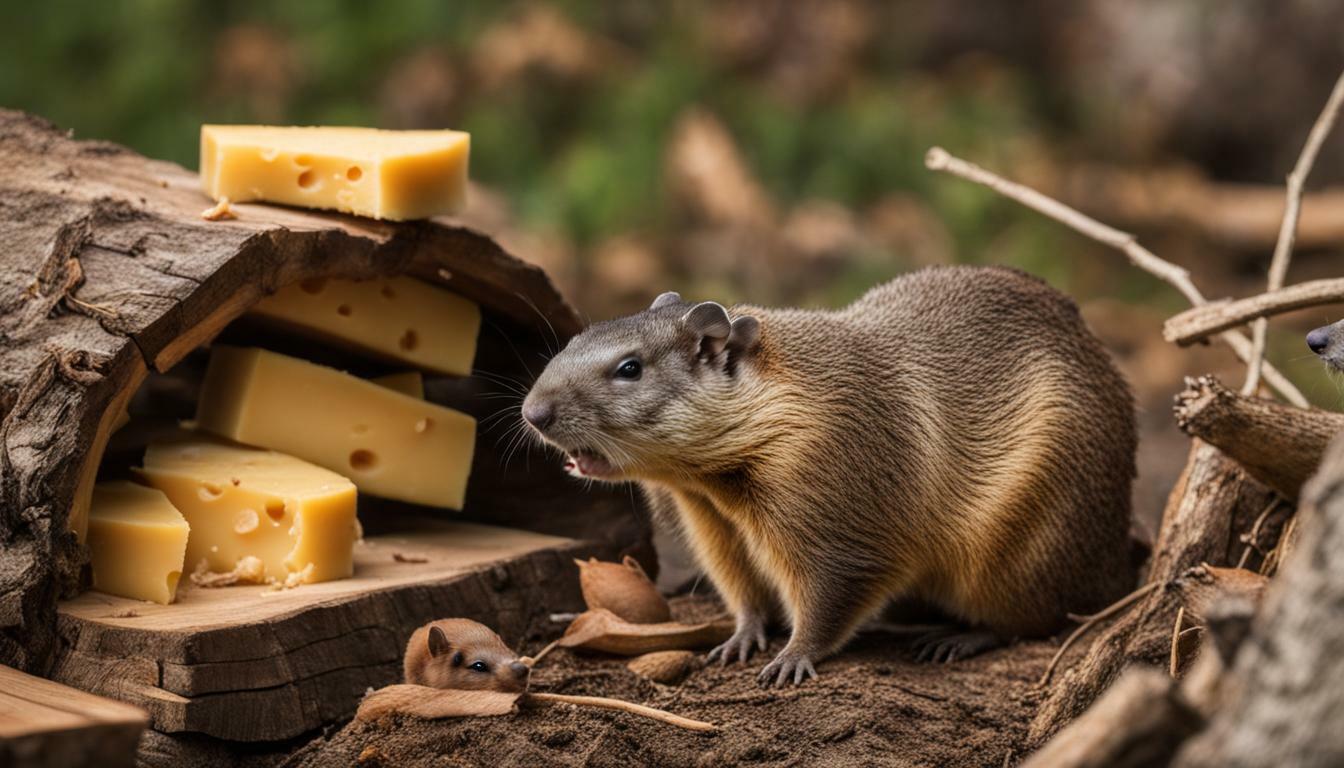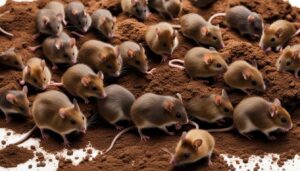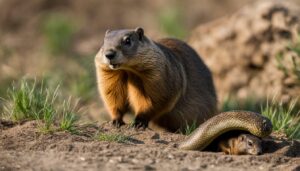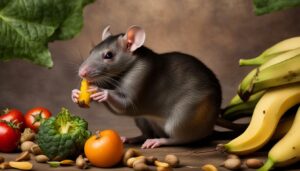Many people wonder, do groundhogs eat mice? Let’s explore the truth behind groundhogs’ dietary habits and their relationship with mice.
Key Takeaways:
- Groundhogs primarily eat plant foods, such as vegetables, fruits, grasses, and tree bark.
- Mice are not a significant part of the groundhog’s diet.
- Groundhogs are herbivores and prefer a variety of plant materials to meet their nutritional needs.
- While groundhogs may occasionally consume small insects and other small animals, mice are not their primary prey.
- Groundhogs and mice may share habitats, but their interactions are generally neutral and unrelated to food consumption.
Groundhog Eating Habits
Groundhogs are primarily herbivores, with a diet consisting of vegetables, fruits, grasses, and tree bark. However, they may occasionally show interest in small insects and even mice. While their main source of nutrition comes from plant-based foods, groundhogs have been known to supplement their diet with small animals on rare occasions.
Groundhogs’ preference for plant foods is rooted in their evolutionary adaptation as herbivores. Their digestive system is designed to efficiently process and metabolize plant materials, allowing them to extract the necessary nutrients to maintain their health and energy levels. As a result, groundhogs prioritize consuming a variety of plant materials to meet their nutritional needs.
It is important to note that while groundhogs may occasionally consume small insects and mice, they do not actively seek out or target them as prey. These instances of consuming small animals are more likely to occur by chance rather than being a deliberate part of their diet. Groundhogs and mice may share habitats in certain environments, but their interactions are generally neutral and unrelated to food consumption.
| Groundhog Eating Habits: | |
|---|---|
| Main Diet: | Vegetables, fruits, grasses, and tree bark |
| Occasional Interests: | Small insects, and rarely, mice |
| Primary Preference: | Plant-based foods |
| Interaction with Mice: | Neutral and unrelated to food consumption |
Groundhog Predation on Mice
While groundhogs are known to consume small animals, their predation on mice is not a common occurrence. Groundhogs mainly focus on their plant-based diet, and any interaction with mice is usually coincidental. These interactions typically occur when groundhogs and mice share habitats, but they are generally neutral and unrelated to food consumption.
Groundhogs are herbivores and prioritize meeting their nutritional needs through a variety of plant materials, such as vegetables, fruits, grasses, and tree bark. Their preference for plant-based foods is evident in their eating habits, where they spend the majority of their time grazing on vegetation.
Occasionally, groundhogs may consume small insects and even other small animals. However, the consumption of mice is not a significant part of their diet. It is important to note that groundhogs do not actively hunt or target mice as prey. Rather, any instances of groundhogs consuming mice are rare and incidental, typically occurring when they come across mice in their shared habitats.
Groundhogs and Mice: Neutral Interactions
Groundhogs and mice may coexist in certain environments and share habitats. However, their interactions are generally neutral and unrelated to food consumption. While groundhogs focus on their plant-based diet, mice are opportunistic foragers and adapt to feed on a range of food sources, including plants and small animals.
In conclusion, groundhogs do not commonly or regularly eat mice. Their diet primarily consists of plant foods, and any consumption of small animals, including mice, is infrequent and incidental. Groundhogs are herbivores, and their interactions with mice are generally neutral and unrelated to food consumption. Understanding the natural coexistence of different species in shared habitats is crucial for observing and appreciating the diversity of wildlife.
| Key Points | |
|---|---|
| Groundhogs are primarily herbivores. | They prefer plant-based foods to meet their nutritional needs. |
| Groundhogs occasionally consume small insects and other small animals. | Mice are not a significant part of their diet. |
| Groundhogs and mice may share habitats, but their interactions are generally neutral and unrelated to food consumption. | Groundhogs do not actively hunt or target mice as prey. |
Groundhogs and Mice: Habitat Interaction
Groundhogs and mice may occasionally cross paths as they inhabit similar environments, but their interactions are typically unrelated to groundhogs seeking mice as prey. Groundhogs, being primarily herbivores, have a diet that consists mainly of plant materials such as vegetables, fruits, grasses, and tree bark. While groundhogs may occasionally consume small insects and other small animals, mice are not a significant part of their regular diet.
Groundhogs are not known to actively hunt or target mice as prey. Instead, their focus is primarily on finding and consuming plant-based foods. This preference for plant materials is due to their evolutionary adaptation as herbivores, allowing them to thrive on a diet rich in nutrients derived from plants.
Though groundhogs and mice may share habitats, their interactions are generally neutral and unrelated to food consumption. Groundhogs create elaborate burrows underground for shelter and to raise their young, while mice may utilize these burrows or establish their own. While groundhogs may encounter mice within these shared habitats, it is important to note that their dietary preferences and interactions are distinct, with groundhogs primarily focusing on plant-based foods and mice having a broader range of food sources.
| Groundhogs | Mice |
|---|---|
| Principally herbivores | Feed on a variety of food sources, including plants and small animals |
| Preference for plant materials | Adapted to consume a diverse range of food sources |
| Occasional consumption of small insects and animals | Do not commonly feed on groundhogs or actively seek them as prey |
In conclusion, groundhogs’ occasional consumption of small animals, including mice, is not a significant part of their diet. Groundhogs primarily rely on plant-based foods to meet their nutritional needs. While groundhogs and mice may share habitats, their interactions are generally neutral and unrelated to groundhogs actively hunting or targeting mice as prey.
Groundhogs’ Herbivorous Nature
Groundhogs are herbivorous animals, meaning they thrive on a diet that includes various plant-based foods like vegetables, fruits, grasses, and tree bark. They have evolved to consume these plant materials to fulfill their nutritional needs. These furry creatures have strong jaws and teeth, which enable them to chew through tough vegetation.
Groundhogs’ herbivorous nature is reflected in their eating habits. They have a preference for fresh greens, such as clover, dandelion leaves, and plant shoots. They also enjoy munching on a variety of fruits, including apples and berries. Additionally, groundhogs will consume grasses and even the bark of trees, especially during the winter months when other food sources may be scarce.
While groundhogs are primarily herbivores, they may occasionally incorporate small insects and other small animals into their diet. However, it is important to note that mice are not a significant part of their regular diet. Groundhogs do not actively seek out or target mice as prey. Instead, they focus on finding and consuming plant foods that provide the necessary nutrients for their survival.
Groundhogs and mice may occasionally cross paths and share habitats, particularly in areas where suitable burrowing locations and food sources are available. However, their interactions are generally neutral and unrelated to food consumption. Groundhogs and mice have very different dietary preferences and do not compete for the same resources. Both species have established their own niche within their shared environments.
| Groundhogs’ Diet: | Mice’s Diet: |
|---|---|
| Plant-based foods (vegetables, fruits, grasses, tree bark) | A wide range of food sources, including plants and small animals |
| Occasional consumption of small insects | Prey on small insects, seeds, grains, and leftover human food |
| Mice are not a significant part of the diet | Mice do not actively seek groundhogs as prey |
Groundhogs’ Dietary Preferences
Groundhogs’ dietary preferences lean heavily towards plant foods, ensuring they get the necessary nutrients from their primary food sources. These furry creatures are primarily herbivores, with a preference for consuming a variety of plant materials.
Vegetables, fruits, grasses, and tree bark make up the majority of a groundhog’s diet. Their strong teeth and jaws are well-suited for gnawing on these plant-based foods, allowing them to extract the necessary nutrients and fiber they need to thrive.
While groundhogs may occasionally consume small insects and other small animals, such as mice, these make up only a small portion of their overall diet. Mice are not a significant part of a groundhog’s menu, as they prefer to focus on plant sources to satisfy their nutritional requirements.
Groundhogs and mice may sometimes share habitats, particularly in grassy or wooded areas. However, their interactions are generally neutral and unrelated to food consumption. Groundhogs do not actively hunt or target mice as prey. Instead, they go about their herbivorous lifestyle, munching on plants and enjoying the abundance of nature.
| Groundhogs’ Dietary Preferences | Examples of Plant Foods |
|---|---|
| Vegetables | Carrots, leafy greens, squash |
| Fruits | Apples, berries, melons |
| Grasses | Grass blades, clover, dandelions |
| Tree Bark | Birch, willow, maple |
So, if you ever come across a groundhog or wonder about their diet, remember that these creatures are primarily plant-eaters. Their inclination towards plant foods ensures they receive the necessary nutrients to support their active lives. And while mice and groundhogs may coexist in the same habitat, their interactions are generally peaceful and unrelated to food preferences.
Groundhog and Mouse Interactions
Groundhogs and mice may coexist in the same habitats, but their interactions are typically unrelated to groundhogs seeking out mice as food. Groundhogs are primarily herbivores, with their diet consisting mainly of plant foods such as vegetables, fruits, grasses, and tree bark. While they may occasionally consume small insects and other small animals, mice are not a significant part of their regular diet.
These interactions between groundhogs and mice can be neutral or even amicable. Both species share similar habitats, such as fields, meadows, and wooded areas. However, their coexistence does not revolve around food consumption. Groundhogs focus on obtaining their nutrition from plant sources, while mice have a more diverse diet that includes both plants and small animals.
The occasional encounter between groundhogs and mice is more a result of overlapping territories rather than intentional predation. Groundhogs are unlikely to actively hunt mice as prey. Instead, they may encounter mice as they go about their daily activities, such as foraging for food or maintaining their burrows. These interactions are usually non-confrontational and have minimal impact on either species.
| Groundhogs | Mice |
|---|---|
| Primarily herbivorous | Omnivorous, feeding on plants and small animals |
| Prefer plant materials for nutritional needs | Adapted to consume a variety of food sources |
| Occasionally consume small insects and animals | May include plants and small animals in their diet |
In conclusion, while groundhogs and mice may share habitats and occasionally encounter each other, their interactions are generally unrelated to groundhogs actively seeking out mice as food. Groundhogs’ herbivorous nature and preference for plant-based foods distinguish them from mice, which have a broader diet. Both species are able to coexist peacefully, with minimal impact on each other’s populations.
Groundhogs’ Occasional Consumption of Small Animals
While groundhogs primarily rely on plant-based foods, they may occasionally consume small insects and even small animals like mice. These instances of consuming small animals are relatively rare and do not make up a significant part of the groundhog’s diet. Groundhogs are herbivores by nature and have evolved to thrive on a diet rich in plant materials.
Groundhogs’ dietary preferences are geared towards fulfilling their nutritional needs through plant-based sources. They have a strong inclination towards vegetables, fruits, grasses, and tree bark, which provide the necessary nutrients for their well-being. These plant foods are readily available in their natural habitats and are the mainstay of their diet. Mice, on the other hand, are not a typical part of the groundhog’s regular food consumption.
Although groundhogs and mice may occasionally share habitats, their interactions are generally neutral and unrelated to food consumption. Groundhogs do not actively seek out or prey upon mice. Their occasional encounters with mice are more a result of their coexistence within similar environments rather than intentional predation. Groundhogs and mice have distinct dietary differences, with groundhogs being primarily herbivores and mice being more adaptable, feeding on a range of food sources including plants and small animals.
| Groundhogs | Mice |
|---|---|
| Primarily herbivores | Adaptable omnivores |
| Preference for plant-based foods | Eat both plants and small animals |
| Occasional consumption of small insects and small animals | Primarily feed on plants and small animals |
In conclusion, while groundhogs may occasionally consume small insects and even small animals like mice, their diet primarily consists of plant foods. The occasional encounters between groundhogs and mice within shared habitats are generally neutral and unrelated to food consumption. Groundhogs have evolved as herbivores, preferring plant-based sources to meet their nutritional needs, and mice have adapted to feed on a range of food sources including plants and small animals.
Groundhogs vs. Mice: Diet Differences
Groundhogs and mice have contrasting dietary habits, with groundhogs being specialized herbivores and mice having a more diverse diet that includes both plant materials and small animals. Groundhogs primarily rely on plant foods, such as vegetables, fruits, grasses, and tree bark, to meet their nutritional needs. Their digestive system is designed to process and extract nutrients from plant materials, making them well-suited for an herbivorous lifestyle. On the other hand, mice have adapted to feed on a range of food sources, including plants and small animals. Their diet is more flexible and opportunistic compared to the selective plant-based diet of groundhogs.
Groundhogs’ Herbivorous Nature
Groundhogs’ herbivorous nature is evident in their preference for plant-based foods. They have evolved to thrive on a diet that is rich in fiber, vitamins, and minerals obtained from various plant materials. Their teeth, especially their incisors, are well-adapted for gnawing and grinding plant matter. Groundhogs’ digestive system is also designed to efficiently process large amounts of plant materials and extract nutrients from them. Although groundhogs may occasionally consume small insects and other small animals, such as mice, these instances are infrequent and do not comprise a significant portion of their diet.
Groundhogs and mice may occasionally share habitats, especially in areas where both species can find suitable shelter and food sources. However, their interactions are generally neutral and unrelated to food consumption. Groundhogs do not actively seek out or target mice as prey. Instead, their focus is mainly on foraging for plant materials that fulfill their nutritional requirements. These occasional encounters between groundhogs and mice within their shared habitats do not indicate a predatory relationship; rather, they are a result of coexisting in the same environment.
In summary, groundhogs and mice have distinct dietary preferences. Groundhogs are specialized herbivores, relying primarily on plant materials for sustenance. Mice, on the other hand, have a more flexible diet that includes both plant materials and small animals. While groundhogs may occasionally consume mice due to their occasional encounters within shared habitats, mice are not a significant part of the groundhog’s regular diet. Understanding these dietary differences and interactions between species is crucial in appreciating the natural coexistence and dynamics of ecosystems.
| Groundhogs | Mice |
|---|---|
| Specialized herbivores | More diverse diet, including both plant materials and small animals |
| Primarily eat plant foods | Opportunistic diet, feeding on a range of food sources |
| Occasionally consume small insects and other small animals | Occasionally consume plant materials and small animals, including other mice |
| Prefer vegetables, fruits, grasses, and tree bark | Adapted to feed on plants and small animals |
Shared Habitats of Groundhogs and Mice
Groundhogs and mice often inhabit the same areas, each contributing to the balance of their shared ecosystem. Groundhogs, being herbivores, primarily rely on plant-based foods to meet their nutritional needs. They consume a variety of plant materials including vegetables, fruits, grasses, and tree bark. On the other hand, mice have adapted to feed on a diverse range of food sources, including plants and small animals.
In their shared habitats, groundhogs and mice may interact, although their interactions are typically neutral and unrelated to food consumption. Groundhogs do not actively seek out or target mice as prey. While groundhogs may occasionally consume small insects and other small animals, mice are not a significant part of their diet.
To better understand the natural coexistence of different species, it is important to recognize that groundhogs and mice have distinct dietary preferences. Groundhogs have evolved as herbivores, whereas mice have adapted to be omnivorous. Despite their occasional encounters, groundhogs and mice maintain their respective dietary patterns without causing significant disruption to each other’s food sources.
Table: Groundhogs and Mice Diet Comparison
| Groundhogs | Mice |
|---|---|
| Eat primarily plant foods | Feast on a diverse range of food sources including plants and small animals |
| Prefer vegetables, fruits, grasses, and tree bark | Consume seeds, grains, insects, fruits, and small animals |
| Avoid actively seeking out or targeting mice as prey | Adapted to hunting and consuming small animals |
In conclusion, groundhogs and mice can coexist in the same habitats, each playing their respective roles in the balance of the ecosystem. While groundhogs have a diet consisting mainly of plant foods, including vegetables, fruits, grasses, and tree bark, mice have a more varied diet that includes both plants and small animals. Their interactions are typically neutral, and groundhogs do not commonly or regularly consume mice as part of their diet. Understanding the dietary preferences and shared habitat interactions of these species can help us appreciate the intricacies of nature’s interconnected web.
Groundhogs’ Primary Diet and Nutritional Needs
Groundhogs’ primary diet of vegetables, fruits, grasses, and tree bark helps them meet their nutritional needs as herbivorous animals. They have evolved to thrive on a plant-based diet, which provides them with the essential nutrients and energy they require to survive and thrive in their natural habitat. Vegetables and fruits offer a rich source of vitamins, minerals, and antioxidants that contribute to their overall health and well-being.
In addition to their consumption of plant materials, groundhogs may occasionally consume small insects and other small animals. However, it is important to note that mice are not a significant part of their diet. While groundhogs and mice may share habitats, their interactions are typically neutral and unrelated to food consumption. Groundhogs do not actively hunt or prey upon mice as a source of sustenance.
Groundhogs’ dietary preferences are largely influenced by their physiology and dentition. Their teeth are adapted to gnaw and chew on plant materials, enabling them to extract nutrients and digest the fibrous components of their diet. They possess powerful jaws and large incisors that are well-suited for breaking down tough plant matter, such as the bark of trees.
Table: Groundhogs’ Primary Diet
| Food Type | Examples |
|---|---|
| Vegetables | Carrots, lettuce, sweet potatoes |
| Fruits | Apples, berries, melons |
| Grasses | Clover, dandelions, timothy grass |
| Tree Bark | Oak, maple, willow |
In summary, groundhogs are primarily herbivores with a diet focused on plant-based foods. While they may occasionally consume small insects and other small animals, mice are not a staple part of their diet. Groundhogs’ preference for vegetables, fruits, grasses, and tree bark enables them to meet their nutritional needs and thrive as herbivorous animals in their natural environment.
Conclusion
In conclusion, groundhogs primarily consume plant materials and do not actively seek out mice as prey. While they may occasionally consume small animals, mice are not a significant part of their diet. Groundhogs are herbivores and prefer to eat a variety of plant materials to meet their nutritional needs.
Their diet consists of vegetables, fruits, grasses, and tree bark, which provide them with the necessary nutrients. Although groundhogs occasionally consume small insects and other small animals, such as mice, these instances are rare and do not make up a substantial portion of their diet.
Groundhogs and mice may share habitats in certain environments, but their interactions are generally neutral and unrelated to food consumption. Groundhogs do not actively hunt or target mice as prey. Instead, they focus on foraging for plant-based food sources to sustain themselves.
FAQ
Do groundhogs commonly eat mice?
No, groundhogs do not commonly or regularly eat mice. Their diet primarily consists of plant foods, such as vegetables, fruits, grasses, and tree bark.
What do groundhogs eat?
Groundhogs are herbivores and prefer to eat a variety of plant materials to meet their nutritional needs. They primarily consume vegetables, fruits, grasses, and tree bark.
Do groundhogs actively hunt mice as prey?
No, groundhogs do not actively seek out or target mice as prey. While groundhogs may occasionally consume small insects and other small animals, mice are not a significant part of their diet.
How do groundhogs and mice interact in their habitats?
Groundhogs and mice may share habitats, but their interactions are generally neutral and unrelated to food consumption. They do not actively hunt or prey on each other.
Are groundhogs primarily herbivores?
Yes, groundhogs are primarily herbivores. They have evolved to rely on plant-based foods to meet their nutritional needs.
What are groundhogs’ dietary preferences?
Groundhogs prefer to consume plant materials over small animals. They prioritize meeting their nutritional needs through vegetables, fruits, grasses, and tree bark.
Do groundhogs consume mice occasionally?
While groundhogs may occasionally consume small animals, including mice, they are not a significant part of their diet. Groundhogs primarily rely on plant foods for sustenance.
What are the differences in diet between groundhogs and mice?
Groundhogs have evolved as herbivores, mainly consuming plant materials. In contrast, mice have adapted to feed on a range of food sources, including plants and small animals.
How do groundhogs and mice interact in shared habitats?
Groundhogs and mice may share habitats in certain environments. Their interactions are typically neutral and unrelated to groundhogs actively hunting mice as prey.
What are groundhogs’ primary dietary needs?
Groundhogs have evolved to thrive on a diet rich in plant materials. They rely on vegetables, fruits, grasses, and tree bark to fulfill their nutritional requirements.




